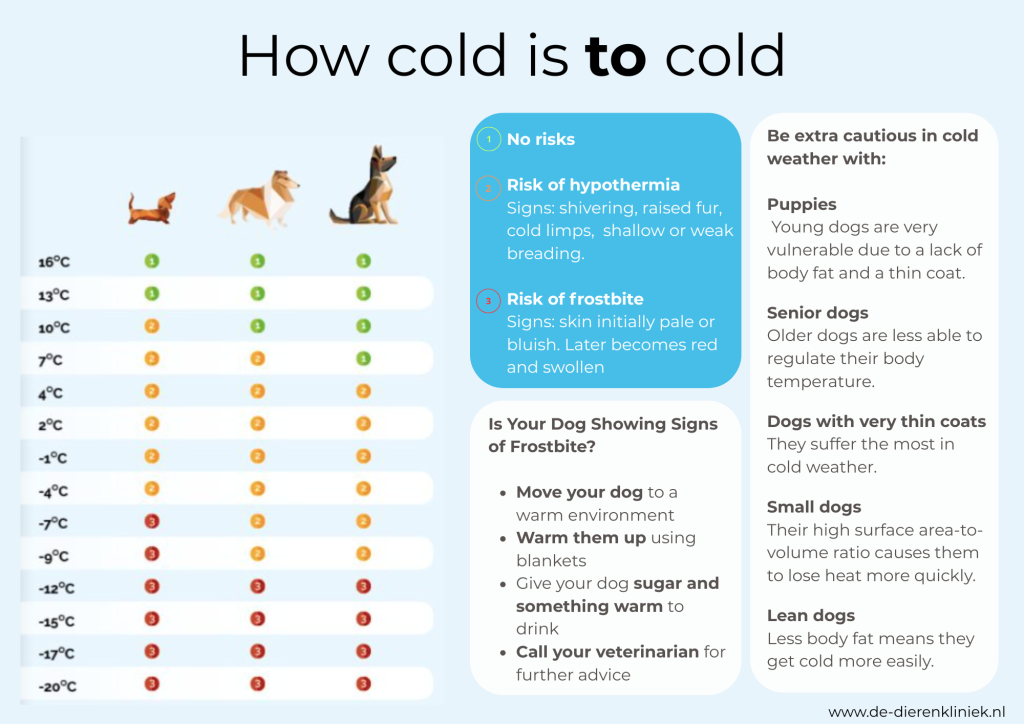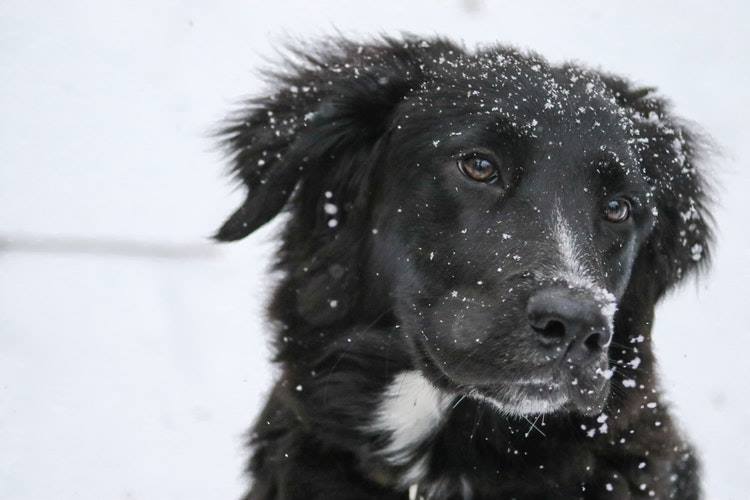When is it too cold outside for my dog?
Most people enjoy the colder seasons. After all, they often come with cozy moments by the fireplace and lots of fun in the snow and ice. And we humans can easily put on an extra layer to stay warm when heading outside.
However, dogs can’t do that, and they often won’t show clear signs when they’re too cold. To ensure your dog also enjoys the cold season, there are several important things to keep in mind.
At what temperatures should I keep my dog indoors?
One of the most frequently asked questions at our clinic is about the effects of outdoor temperatures on dogs. Understandably so, every dog is different. The infographic below shows when you should be extra cautious.

Small dogs
In general, small dogs are less tolerant of the cold. This is often due to their shorter coats and lower body fat. Most small dogs show signs of discomfort at around 8 °C (46 °F).
Medium-sized dogs
Medium dogs can handle cold better than small dogs, but don’t overestimate them. The first signs of discomfort typically appear around 5 °C (41 °F). Watch your dog carefully as temperatures approach freezing.
Large dogs
Large dogs usually cope well with the cold. They have a thicker fat layer, and their bodies lose less heat than smaller dogs. The first signs of cold discomfort usually occur around 3 °C (37 °F). Still, large dogs can become too cold in very low temperatures, so always remain alert.
Risk Factors
How well your dog tolerates the cold depends on its breed, but individual differences matter too. Several additional factors can make your dog more vulnerable to cold:
- Coat thickness – The thinner the coat, the faster your dog will get cold.
- Bare belly – Dogs with hairless bellies cool down more quickly.
- Age – Puppies and senior dogs are more sensitive to the cold due to less effective temperature regulation.
- Illness – Sick dogs are more susceptible to cold; be extra cautious.
- Wind and rain – These intensify the effects of cold.
- Melting snow – Snowballs can stick to the coat, causing discomfort and faster cooling
Signs that your dog is cold
You can recognize if your dog is cold or cooling down by the following signs:
- Shivering
- Labored breathing
- Weakening heartbeat
- Withdrawal, lack of interest in play or social interaction
If you notice one or more of these signs, keep a close eye on your dog and try to make them more comfortable. Severe cooling can lead to hypothermia.
Monitor your dog’s body temperature
A dog’s normal body temperature is between 38 °C and 39 °C (100.4–102.2 °F). Physical activity and stress may raise this by up to 1 °C (1.8 °F), while cold can cause it to drop quickly. A slight drop isn’t concerning, but if it falls below 37.5 °C (99.5 °F) and your dog starts acting unusually, we recommend contacting us for advice.
It’s important to measure temperature accurately—ideally with a digital thermometer for humans. Feeling the ears is not a reliable method.

Take good care of your dog’s paws
It’s especially important to care for your dog’s paws in winter, primarily because of road salt. Salt can stick to their paws or get into open cuts. After walks, rinse their paws with lukewarm water to remove salt and prevent ingestion.
To avoid salt and snow clumps sticking to their paws, which can be painful, you can apply Vaseline or a special paw balm. Vaseline is not toxic to dogs, but make sure it’s free of additives.
Fact or myth: dog paws stay warm in winter
Contrary to popular belief, dogs generally don’t suffer from cold paws. Blood vessels that carry warm blood to and from the paws are located very close to each other. Warm blood from the heart helps heat up the returning colder blood, allowing dogs to maintain a stable internal temperature effectively.
What to do if your dog is hypothermic
If your dog is showing signs of hypothermia, take the following steps:
- Move your dog to a warm environment
- Offer sugar or warm drinks (e.g., glucose water)
- Wrap your dog in blankets to warm them up
- Contact your veterinarian immediately
Schedule an appointment
Does your dog show signs of hypothermia or frostbite? Don’t wait—Book an appointment. We’ll help your dog recover quickly!

Our clinics
Our clinics
Whether you come to Amsterdam or Heemstede, you will hardly notice the difference. The atmosphere is homely and warm and we welcome our clients and patients with a smile and lots of patience.
See our clinics here

